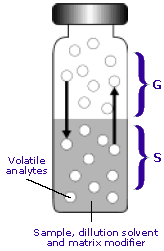Category:Headspace
From LEAP
| Line 18: | Line 18: | ||
[http://www.labhut.com/education/headspace/introduction01.php For more information:] | [http://www.labhut.com/education/headspace/introduction01.php For more information:] | ||
| + | |||
| + | |||
| + | ---- | ||
| + | [[Image:LEAP Logo.png|frame|www.leaptec.com<br>www.leapwiki.com]] | ||
| + | |||
| + | === Contact LEAP === | ||
| + | |||
| + | For additional information about this technique please contact LEAP Technologies for detailed information | ||
| + | |||
| + | * [http://www.leaptec.com/contact-us.php Contact the LEAP office] | ||
| + | <bf><br> | ||
Revision as of 16:05, 30 April 2009
Basic Principles of Headspace Analysis
A headspace sample is normally prepared in a vial containing the sample, the dilution solvent, a matrix modifier and the headspace. Volatile components from complex sample mixtures can be extracted from non-volatile sample components and isolated in the headspace or gas portion of a sample vial. A sample of the gas in the headspace is injected into a GC system for separation of all of the volatile components.
Phases of the Headspace Vial
G = the gas phase (headspace)
The gas phase is commonly referred to as the headspace and lies above the condensed sample phase.
S = the sample phase The sample phase contains the compound(s) of interest. It is usually in the form of a liquid or solid in combination with a dilution solvent or a matrix modifier.
Once the sample phase is introduced into the vial and the vial is sealed, volatile components diffuse into the gas phase until the headspace has reached a state of equilibrium as depicted by the arrows. The sample is then taken from the headspace.
Contact LEAP
For additional information about this technique please contact LEAP Technologies for detailed information
<bf>
Pages in category "Headspace"
The following 5 pages are in this category, out of 5 total.


